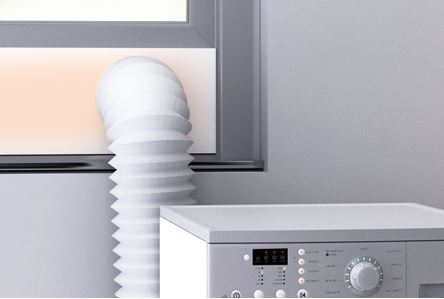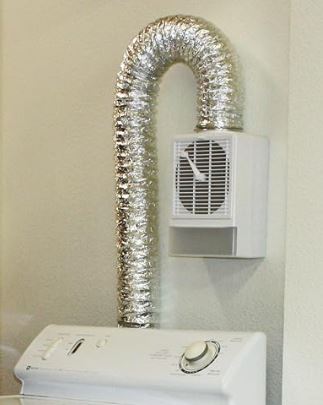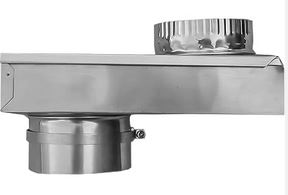Due to the likelihood of encountering obstacles while rerouting a dryer’s vent to the outside, it’s never easy figuring out how to vent a dryer in the middle of the house. That, however, doesn’t make it impossible, as there are six easy ways to do it.
You can vent a dryer in the middle of the house through the nearest shaft, crawl space, interior wall, window, or drop ceiling or using periscopes, and it’s easier than you think.
Of course, the choice of the venting technique depends on your house setup and the obstacles you are likely to encounter. I’ll take you through all the six ways to help you choose the one that most suits your dryer and home.
But first, we’ll answer one crucial question – do you have to vent out your dryer? What happens if you don’t? Let’s dive in!

In a rush? Below is an overview of the six ways you can vent a dryer outside
How to Vent a Dryer Outside – Quick Summary
| – | Venting Means | Suitability |
| 1. | Nearest Shaft | When you can easily access vertical spaces near the dryer |
| 2. | Crawl Spaces | When you can access an open basement via crawl spaces |
| 3. | Nearest Interior Wall | When there is no obstacle between the dryer and the nearest interior wall |
| 4. | Nearest Window | When there is no obstacle between the dryer and the nearest window |
| 5. | Drop Ceiling | When the drop ceiling is within the dryer’s range |
| 6. | Using Periscopes | When there are obstacles in the middle of your house |
Does A Dryer Vent Have to Be Vented Outside?
Why go through the hassle of trying to vent out the dryer? Well, as long as you have a gas dryer, you’ve to vent it outside for the sake of your safety. Failure to vent out the dryer will result in these risks that you wouldn’t want:
- Fire Hazard – By venting out the dryer, you also eliminate excess lint, which could spark a fire.
- Mold Growth – Dryers create a humid environment, which often encourages mold growth. To avoid such conditions, you should vent out the excess dampness.
- Structure Damage – The dryer’s dampness encourages mold growth and could damage the walls and floors. That’s why most local building codes require you to vent out your dryer.
- Poor Air Quality – You need clean air around you when at home. That may not be the case if your dryer doesn’t vent out and the carbon monoxide-polluted air is allowed to circulate indoors.
In addition to the above, you should vent out your dryer to improve its efficiency. That includes electric dryers.
So, while electric dryers don’t emit carbon monoxide like gas dryers, they need good airflow to work efficiently. If you don’t give them that, you’ll overwork and wear down the dryer much quicker than you imagine.
How to Vent a Dryer in The Middle of the House?
Now that you know the importance of venting out your dryer, here are six ways you can do it from the middle of your house:
1. Through the Nearest Shaft
You can vent out your dryer from the middle of the house using existing shafts or vertical spaces. This technique works when there are no obstacles in the middle of the house, as you’ll need to use the vertical space to create a conduit for the exhaust vent.
How to do it:
- Identify an existing vertical shaft nearest to the dryer
- Ensure the vertical shaft runs from the mid-floor to the house’s roof
- Install a metal duct along the vertical space
- Fit a roof vent at the duct end and cover it to stop water from getting in
- Secure the connections to prevent leakage and improve smooth airflow
2. Through Crawl Spaces
Instead of venting the dryer upwards, as is the first case, you can vent it downwards through an open basement. This technique requires you to identify and use crawl spaces that lead to the basement.
How to do it:
- Install a metal duct along a crawl space that leads to an open basement
- Reroute the dryer vent through the established crawl space (consult the local building codes here so as not to break the law)
- Extend the metal duct to the exterior of the house via the wall
- Install a dryer vent cover/cap on the exterior to stop debris from getting in while allowing exhaust air to escape
- Secure the vent firmly

3. Through an Interior Wall
You can also vent out a dryer by fitting a duct that runs through your house’s interior wall to the outside.
What to do:
- Locate an interior wall closest to the dryer, one with fewer obstacles
- Cut in two separate holes on the interior wall to pass the duct
- Fit the duct to the back end of your dryer tightly and pass it through the house’s interior wall
- Firmly support it using brackets
4. Through the Nearest Window
It’s also possible to vent out the dryer through the closest window. You, however, need a window dryer vent kit (View on Amazon), which you’ll mount on the window.
Window dryer vent kits usually come with installation instructions you must follow.
5. Through the Drop Ceiling
If you cannot access the outside of your house via the basement, you can do it through the ceiling. This venting option requires passing the dryer vent above the ceiling and rerouting it to the exterior vent.
6. Using Periscopes
Lastly, if there are obstacles in the middle of your house, you need a venting solution that you can angle around the barrier, and that’s where periscopes, also known as offset ducts, come in. You can use them when you have to circumnavigate a wall or cabinet.
What to do:
Here are five key steps to vent out a dryer using periscopes:
Step 1 – Install the 1st periscope
Locate the 1st periscope, angle it to 90 degrees, and set it according to your dryer. The periscope end should be raised above the vent opening on the other side of your house.
If you don’t do that, air won’t escape the dryer. Instead, the periscope will force air in, and you don’t want that.
Step 2 – Install the 2nd periscope
Now that the 1st periscopeis is in place, install the second. You, however, need an extra set of hands to do this. Use screws to hold the periscope and the hose together once you are through with the installation.
Step 3 – Seal up the periscopes
Though it helps to screw the periscope firmly, it doesn’t stop leakage. You’ve to seal it properly, and you can use metal tape or silicone caulk. While at it, apply the sealant outside the vent and not inside to avoid obstructing any airflow.
Step 4 – Affix the PVC piping
Cut the PVC pipes according to size and then screw them to the periscopes. After that, seal up the new connection with the sealant.
Step 5 – Replace the vent hose
Lastly, unscrew the old vent and fit in a new one with the periscopes. Of course, this step is optional as it depends on whether the vent needs replacing.

Tips for Venting a Dryer in the Middle of the House
Here are tips worth remembering when venting out a dryer in the middle of the house:
- Consult your local building codes and observe all regulations
- Consult a pro contractor
- Regularly clean the dryer vent
Can You Use a Dryer Without Venting It Outside?
You can use a dryer, especially an electric-powered option, without venting it outside. It’s, however, not recommendable because of the safety risks associated with it.
Besides, if you must use the dryer without venting it outside, you must find ways to vent it inside. That will not only improve the dryer’s performance but will also minimize the safety and health risks.
Dryer Vent Alternatives
While nothing replaces the dryer vent 100%, you can still vent out your dryer without it, and here are some of its most recommended alternatives:
- Indoor lint trap (for electric dryers only) – Consider using an indoor lint trap (View on Amazon) if you have an electric dryer. Gas dryers release carbon monoxide, which an indoor lint trap can’t stop. They can only trap dust and lint.
- Window dryer vent kit – Which I shared earlier. Unlike indoor lint traps, you can use a window dryer vent kit on a gas dryer.
- Through the roof – You can also vent your dryer through the ceiling.
Remember, you can also go for a vent-less dryer. Such a dryer doesn’t need venting outside.
People Also Ask
1. What Happens If I Run My Dryer Without a Vent?
There’s danger in running a dryer without a vent. The first danger is that it creates dampness, which could spark mildew and mold growth, which is bad for indoor air quality and water safety.
The dampness can also damage your building structure, especially the mold. Another danger is that your dryer, especially if it’s gas, will emit carbon monoxide, one of the most lethal gases on earth, and you can’t risk that.
Last but not least, the lint discharged may spark a fire, which could be fatal and too costly for you. So, it’s good to vent out your dryer to avoid all these risks.
2. What If My House Does Not Have a Dryer Vent?
If your house lacks a dryer vent, you can choose to vent it through the window, and you need to install a window dryer vent kit to do that. Alternatively, you can use an interior lint trap if it’s an electric dryer. Gas dryers won’t work with a lint trap as the detachable filter doesn’t get rid of harmful carbon monoxide gas. It only traps dust and lint.
3. Do Dryers Have to Vent Outside?
No, dryers don’t have to vent outside. You can vent them inside. The danger of that, however, is that the dampness and polluted air don’t go away. It only diffuses indoors. For that reason, venting the dryer outside is highly advisable.
Concluding Thought:
Now you know how to vent a dryer in the middle of the house. As shared, you can do it through the nearest shaft, craft space, drop ceiling, window, or interior window if there aren’t direct obstacles. However, if immediate barriers exist, you can use periscopes, and you have the quick process of their installation above.
Overall, what’s important is having to vent out your dryer as you wouldn’t want to risk its safety and health risks. And even if it’s an electric dryer, you want it to work efficiently, which calls for uninterrupted venting.
Also Read:
